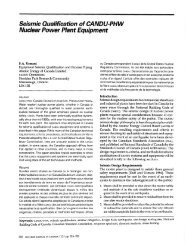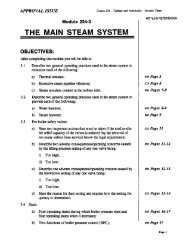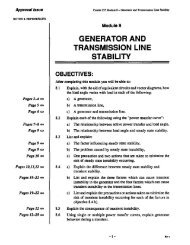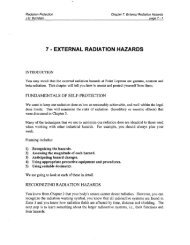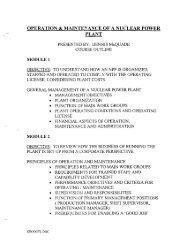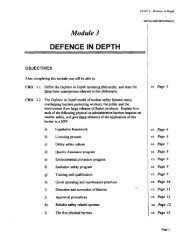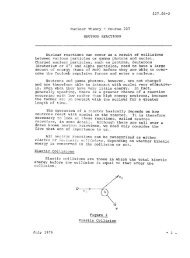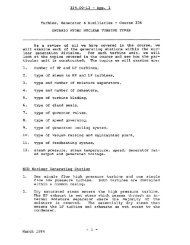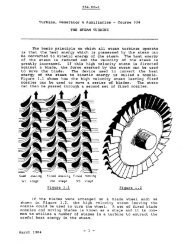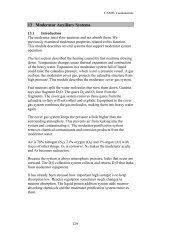CANDU Safety #20 - Probabilistic Safety Analysis - Canteach
CANDU Safety #20 - Probabilistic Safety Analysis - Canteach
CANDU Safety #20 - Probabilistic Safety Analysis - Canteach
You also want an ePaper? Increase the reach of your titles
YUMPU automatically turns print PDFs into web optimized ePapers that Google loves.
<strong>CANDU</strong> <strong>Safety</strong><br />
<strong>#20</strong> - <strong>Probabilistic</strong> <strong>Safety</strong> <strong>Analysis</strong><br />
V.G. Snell R. Jaitly<br />
<strong>Safety</strong> & Licensing <strong>CANDU</strong> 6/9 PSA<br />
24/05/01 <strong>CANDU</strong> <strong>Safety</strong> - <strong>#20</strong> - <strong>Probabilistic</strong> <strong>Safety</strong> <strong>Analysis</strong>.ppt Rev. 0 vgs 1
Topics<br />
λ What is a PSA?<br />
λ History<br />
λ Acceptance Criteria<br />
λ Elements Of PSA<br />
λ PSA as a Decision Making Tool<br />
λ Results of <strong>CANDU</strong> PSAs<br />
λ Recent PSA Developments<br />
24/05/01 <strong>CANDU</strong> <strong>Safety</strong> - <strong>#20</strong> - <strong>Probabilistic</strong> <strong>Safety</strong> <strong>Analysis</strong>.ppt Rev. 0 vgs 2
Use of <strong>Probabilistic</strong> <strong>Safety</strong> <strong>Analysis</strong> (PSA)<br />
λ provides a numerical measure of plant risk to the public<br />
– identifies the potential accidents, calculates their<br />
probability of occurrence, and their consequences<br />
– the product of frequency of postulated accidents and their<br />
consequences provides an estimate of plant risk<br />
λ develops mathematical model that relates plant risk to<br />
contributory factors: plant configuration, equipment reliability, reliability,<br />
operator error probability, operating practices, plant response,<br />
and system capability<br />
λ design assist & audit tool<br />
– fix it first, not calculate it after<br />
24/05/01 <strong>CANDU</strong> <strong>Safety</strong> - <strong>#20</strong> - <strong>Probabilistic</strong> <strong>Safety</strong> <strong>Analysis</strong>.ppt Rev. 0 vgs 3
PSAs by AECL<br />
λ first probabilistic assessment: Douglas Point (1960s)<br />
λ early PSAs for <strong>CANDU</strong> 6, Pickering B, Bruce B (1978 to 1983)<br />
λ <strong>CANDU</strong> 6 PSA with KEMA (The Netherlands) (1985-1987) (1985 1987)<br />
λ Wolsong 2, 3 & 4 PSA (1992-1996) (1992 1996)<br />
λ <strong>CANDU</strong> 9 PSA (1995-) (1995<br />
λ Qinshan 1 & 2 PSA (1997-)<br />
(1997<br />
24/05/01 <strong>CANDU</strong> <strong>Safety</strong> - <strong>#20</strong> - <strong>Probabilistic</strong> <strong>Safety</strong> <strong>Analysis</strong>.ppt Rev. 0 vgs 4
PSAs by Others<br />
λ Ontario Hydro<br />
– Darlington Risk Assessment (1987-88) (1987 88)<br />
– Pickering “A” Risk Assessment (1995)<br />
– Bruce “B” Risk Assessment (in progress)<br />
λ Korea<br />
– Wolsong 2 PSA with external events (1998)<br />
λ Romania<br />
– PSA studies on Cernavoda 1 (in progress)<br />
24/05/01 <strong>CANDU</strong> <strong>Safety</strong> - <strong>#20</strong> - <strong>Probabilistic</strong> <strong>Safety</strong> <strong>Analysis</strong>.ppt Rev. 0 vgs 5
PSA Acceptance Criteria<br />
λ Level 1 PSA acceptance criteria: guide to designers, not a<br />
regulatory target<br />
– frequency of individual event sequences resulting in severe<br />
core damage < 10 -6 events per year<br />
– frequency of individual event sequences requiring<br />
moderator to function as heat sink < 10 -5 events per year<br />
λ related to <strong>Safety</strong> Goals in earlier lecture<br />
24/05/01 <strong>CANDU</strong> <strong>Safety</strong> - <strong>#20</strong> - <strong>Probabilistic</strong> <strong>Safety</strong> <strong>Analysis</strong>.ppt Rev. 0 vgs 6
Level<br />
3<br />
PSA<br />
PSA Scope<br />
Level<br />
2<br />
PSA<br />
Level<br />
1<br />
PSA<br />
Steps in PSA <strong>Analysis</strong> Consequence<br />
<strong>Analysis</strong><br />
Input to Process<br />
1. Selection of Initiating<br />
Events<br />
2. Event Sequence <strong>Analysis</strong><br />
3. Event Tree <strong>Analysis</strong><br />
4. Fault Tree <strong>Analysis</strong><br />
5. Fault Tree M erging<br />
6. Containment Event Tree<br />
←<br />
←<br />
←<br />
P hysics, F uel, &<br />
Therm alhydraulic<br />
A nalysis<br />
B ehaviour in<br />
Containm ent<br />
A tm ospheric<br />
D ispersion &<br />
D ose<br />
Calculations
Elements of PSA<br />
λ Identification of Initiating Events<br />
λ Event Sequence Diagrams<br />
λ Event Tree <strong>Analysis</strong><br />
λ Fault Tree <strong>Analysis</strong><br />
λ Human Reliability <strong>Analysis</strong><br />
λ Accident Sequence Quantification<br />
λ Recovery <strong>Analysis</strong><br />
λ Common Cause Failure <strong>Analysis</strong><br />
λ Uncertainty & Sensitivity <strong>Analysis</strong><br />
λ Level 2 & Level 3 PSA<br />
24/05/01 <strong>CANDU</strong> <strong>Safety</strong> - <strong>#20</strong> - <strong>Probabilistic</strong> <strong>Safety</strong> <strong>Analysis</strong>.ppt Rev. 0 vgs 8
Worked Example - A Car Braking System<br />
λ Event tree: What are the consequences of failure of the normal<br />
car braking system?<br />
λ Fault tree: What is the probability of failure of the normal car<br />
braking system on demand?<br />
Basic Event Undeveloped Event Intermediate Event<br />
24/05/01 9:19 AM Risk for Science Teachers.ppt Rev. 1 vgs 9
A Few Symbols<br />
λ AND gate:<br />
– event A AND event B must occur in<br />
order for event C to occur<br />
λ OR gate:<br />
– event A OR event B must occur in order<br />
for event C to occur<br />
AND<br />
A B<br />
24/05/01 9:19 AM Risk for Science Teachers.ppt Rev. 1 vgs 10<br />
C<br />
C<br />
OR<br />
A B
Event Tree - Example<br />
Car brakes fail<br />
on demand<br />
0.0057<br />
Yes<br />
No<br />
0.7<br />
0.3<br />
Operator<br />
Emergency<br />
Brakes<br />
0.9<br />
0.1<br />
Down-<br />
shift<br />
Engine Crash<br />
Probability<br />
24/05/01 9:19 AM Risk for Science Teachers.ppt Rev. 1 vgs 11<br />
0.7<br />
0.3<br />
0.3<br />
0.7<br />
0.00008<br />
0.0017<br />
Total 0.00178
Fault tree - Example<br />
No brake fluid Broken<br />
Linkage<br />
AND<br />
Car fails to stop when pedal is pushed<br />
OR<br />
Circuit 1 empty Circuit 2 empty<br />
Seized<br />
brake<br />
Worn<br />
Pads<br />
24/05/01 9:19 AM Risk for Science Teachers.ppt Rev. 1 vgs 12
Fault Tree with Sample Demand Probabilities<br />
No brake fluid Broken<br />
Linkage<br />
AND<br />
0.0001*<br />
Car fails to stop when pedal is pushed<br />
OR<br />
Circuit 1 empty Circuit 2 empty<br />
~0.0057<br />
Seized<br />
brake<br />
0.0001 0.0005<br />
0.01 0.01<br />
Why is this too high?<br />
Worn<br />
Pads<br />
*Assuming events are<br />
independent<br />
24/05/01 9:19 AM Risk for Science Teachers.ppt Rev. 1 vgs 13<br />
0.005
Event Tree - Nuclear Power Plant<br />
λ an event tree represents various possible scenarios which can<br />
result from the same initiating event<br />
λ the end-point end point of an event tree is either a stable condition or a<br />
Plant lant Damage amage State tate<br />
λ quantitatively it ties together the reliability of different systems systems<br />
λ fault tree analysis and operating experience is used to<br />
estimate initiating event frequency<br />
24/05/01 <strong>CANDU</strong> <strong>Safety</strong> - <strong>#20</strong> - <strong>Probabilistic</strong> <strong>Safety</strong> <strong>Analysis</strong>.ppt Rev. 0 vgs 14
Typical Event Tree Branch Points for <strong>CANDU</strong><br />
1. Initiating Event<br />
2. Reactor Shutdown<br />
3. Bleed Condenser Bottle-up Bottle up if LRVs opened<br />
4. Class IV Power Available<br />
5. Group 1 Odd Class III Energized<br />
6. Group 2 Odd Class III Energized<br />
7. Group 1 Even Class III Energized<br />
8. Group 2 Even Class III Energized<br />
9. Instrument Air Available<br />
10. Service Water Available<br />
11. Operator Action<br />
12. Preferred Heat Sink<br />
13. Alternate Heat Sink<br />
24/05/01 <strong>CANDU</strong> <strong>Safety</strong> - <strong>#20</strong> - <strong>Probabilistic</strong> <strong>Safety</strong> <strong>Analysis</strong>.ppt Rev. 0 vgs 15
Typical Fault Trees for <strong>CANDU</strong><br />
λ loss of electrical power<br />
λ loss of feedwater<br />
λ steam main break<br />
λ loss of coolant accident<br />
λ loss of flow<br />
λ loss of computer control<br />
λ loss of support services:<br />
– instrument air, process water<br />
λ loss of reactivity control<br />
λ etc.<br />
24/05/01 9:19 AM Risk for Science Teachers.ppt Rev. 1 vgs 16
Fault Tree <strong>Analysis</strong><br />
λ identifies:<br />
– most likely system failure modes<br />
– potential weaknesses in system design and operation<br />
λ basic events include random equipment failures, human<br />
errors, and test and maintenance unavailabilities<br />
λ component failure database from various sources:<br />
– Darlington Risk Assessment<br />
– IEEE Standard 500<br />
– Nuclear Plant Reliability Data System<br />
– IAEA Tech Doc 478<br />
– Point Lepreau observed component reliability report<br />
24/05/01 <strong>CANDU</strong> <strong>Safety</strong> - <strong>#20</strong> - <strong>Probabilistic</strong> <strong>Safety</strong> <strong>Analysis</strong>.ppt Rev. 0 vgs 17
Level 2 PSA<br />
λ Level 1 PSA plus containment performance & source terms at<br />
containment boundary<br />
λ requires severe core damage accident analysis for beyond-<br />
design-basis design basis events identified in the Level 1 PSA, e.g.:<br />
– core debris formation & progression<br />
– thermohydraulics of core debris in calandria<br />
– hydrogen production<br />
– containment performance<br />
24/05/01 <strong>CANDU</strong> <strong>Safety</strong> - <strong>#20</strong> - <strong>Probabilistic</strong> <strong>Safety</strong> <strong>Analysis</strong>.ppt Rev. 0 vgs 18
PSA Role in Severe Accident Mitigation Design<br />
λ PSA gives a precise definition of severe accident sequences<br />
including the identification of support system failures. This<br />
helps assess the adequacy of:<br />
– long term containment mitigating features (e.g. support<br />
services for air coolers, hydrogen control)<br />
– long term heat removal capability of shield cooling and<br />
moderator systems<br />
24/05/01 <strong>CANDU</strong> <strong>Safety</strong> - <strong>#20</strong> - <strong>Probabilistic</strong> <strong>Safety</strong> <strong>Analysis</strong>.ppt Rev. 0 vgs 19
PSA - Design Assist Role<br />
λ safety design assistance at an early stage - ensure adequate<br />
redundancy & functional separation<br />
λ identify risk-dominant risk dominant accident sequences<br />
λ obtain an understanding of the integrated plant response to<br />
abnormal events<br />
λ identify operator actions & provide input to control centre<br />
design & Emergency Operating Procedures<br />
λ provide input to Environmental Qualification programme<br />
λ provide input to test & maintenance programmes<br />
24/05/01 <strong>CANDU</strong> <strong>Safety</strong> - <strong>#20</strong> - <strong>Probabilistic</strong> <strong>Safety</strong> <strong>Analysis</strong>.ppt Rev. 0 vgs 20
PSA Has Resulted in Changes During Design<br />
Station Design Change Requests (DCRs ( DCRs) ) from PSA studies<br />
STATION APPROVED REQUEST<br />
Gentilly-2 Gentilly<br />
92<br />
Point Lepreau Unit 1 66<br />
Wolsong Unit 1 37<br />
Pickering “B” 22<br />
Bruce “B” 17<br />
Approximately 80% of the approved design changes were with the balance balance<br />
of<br />
plant and service systems (non-nuclear (non nuclear portion).<br />
24/05/01 <strong>CANDU</strong> <strong>Safety</strong> - <strong>#20</strong> - <strong>Probabilistic</strong> <strong>Safety</strong> <strong>Analysis</strong>.ppt Rev. 0 vgs 21
Design Changes Identified by Darlington PSA<br />
λ number of design problems identified (and changes made)<br />
105<br />
λ breakdown of changes:<br />
– process control 74%<br />
– process or equipment arrangement 12%<br />
– power supply allocation 6%<br />
– equipment design 4%<br />
– others 4%<br />
24/05/01 <strong>CANDU</strong> <strong>Safety</strong> - <strong>#20</strong> - <strong>Probabilistic</strong> <strong>Safety</strong> <strong>Analysis</strong>.ppt Rev. 0 vgs 22
Design Changes Identified by Wolsong 2 PSA<br />
λ ECC design changes<br />
– automatic start of recovery pumps<br />
– greater redundancy for certain valves<br />
– increased test frequency of certain valves<br />
λ improved design for heat transport system pump high bearing<br />
temperature automatic trip<br />
λ for screen wash system, change failure position of certain<br />
valves to “fail close” on loss of instrument air<br />
λ code classification upgrade for boiler blowdown piping inside<br />
containment<br />
24/05/01 <strong>CANDU</strong> <strong>Safety</strong> - <strong>#20</strong> - <strong>Probabilistic</strong> <strong>Safety</strong> <strong>Analysis</strong>.ppt Rev. 0 vgs 23
<strong>CANDU</strong> 9 Enhancements Based on Earlier PSAs<br />
λ improved feedwater reliability<br />
– 2 independent sources of high pressure feedwater<br />
– auxiliary diesel-driven diesel driven pump<br />
λ two groups of service water supply to shutdown cooler<br />
λ 4 onsite diesel-generators<br />
diesel generators - low station blackout frequency<br />
λ improved ECC reliability<br />
– elimination of check valves<br />
– automatic recirculation phase<br />
– sustained low Reactor Outlet Header pressure conditioning<br />
– elimination of medium pressure ECC<br />
24/05/01 <strong>CANDU</strong> <strong>Safety</strong> - <strong>#20</strong> - <strong>Probabilistic</strong> <strong>Safety</strong> <strong>Analysis</strong>.ppt Rev. 0 vgs 24
<strong>CANDU</strong> 9 Changes Supported by PSA<br />
λ automatic heat transport system pump trip on high bearing<br />
temperature<br />
λ passive make-up make up capability to heat transport system,<br />
moderator, boilers & end-shields<br />
end shields<br />
λ moderator make-up make up from reactor building floor<br />
λ relocation of service water pumps for protection against steam<br />
line break<br />
24/05/01 <strong>CANDU</strong> <strong>Safety</strong> - <strong>#20</strong> - <strong>Probabilistic</strong> <strong>Safety</strong> <strong>Analysis</strong>.ppt Rev. 0 vgs 25
Summary of <strong>CANDU</strong> PSA Results<br />
(Internal Events)<br />
λ Summed severe core damage frequency for Wolsong 2<br />
= 6.1 x 10 -6 /yr.<br />
λ Summed severe core damage frequency for Darlington<br />
= 3.8 x 10 -6 /yr.<br />
λ Summed severe core damage frequency for <strong>CANDU</strong> 6 (KEMA)<br />
= 4.6 x 10 -6 / yr.<br />
λ Summed severe core damage frequency due to failure to<br />
shutdown<br />
= 3 x 10 -8 / yr. (typical)<br />
24/05/01 <strong>CANDU</strong> <strong>Safety</strong> - <strong>#20</strong> - <strong>Probabilistic</strong> <strong>Safety</strong> <strong>Analysis</strong>.ppt Rev. 0 vgs 26
Wolsong 2 Summed Severe Core Damage<br />
Frequency<br />
Summation = 6.1 E-6 Events/Year<br />
End Shield Cooling<br />
Failure<br />
16%<br />
Small Steam Line<br />
Failure<br />
7%<br />
Pressure Tube<br />
Rupture<br />
2%<br />
Loss of Service<br />
Water<br />
12%<br />
Other<br />
8%<br />
Loss of Feedwater<br />
Supply<br />
3%<br />
Digital Control<br />
Computer Failure<br />
17%<br />
Loss of Class IV<br />
Power<br />
24%<br />
General Transient<br />
6%<br />
Loss of Instrument<br />
Air<br />
5%<br />
24/05/01 <strong>CANDU</strong> <strong>Safety</strong> - <strong>#20</strong> - <strong>Probabilistic</strong> <strong>Safety</strong> <strong>Analysis</strong>.ppt Rev. 0 vgs 27
Recent <strong>CANDU</strong> PSA Related Developments<br />
λ detailed PSA for “beyond-design<br />
“beyond design-basis” basis” external events<br />
(seismic, fire, flooding)<br />
– Korean study is instructive<br />
– AECL programme underway to review <strong>CANDU</strong> 6 & <strong>CANDU</strong> 9<br />
λ Common Cause Failure <strong>Analysis</strong><br />
λ tests & models for <strong>CANDU</strong> severe accident progression<br />
λ increased use of PSA models / insights in the day-to day to-day day<br />
running of stations:<br />
– outage planning<br />
– risk impact of changes in plant configuration, test<br />
frequencies, on line equipment maintenance<br />
24/05/01 <strong>CANDU</strong> <strong>Safety</strong> - <strong>#20</strong> - <strong>Probabilistic</strong> <strong>Safety</strong> <strong>Analysis</strong>.ppt Rev. 0 vgs 28
Conclusions<br />
λ PSA is most cost-effective cost effective when used as a design tool<br />
because the plant can be strengthened before it is built<br />
λ core damage frequencies for <strong>CANDU</strong> reflect the role of the<br />
moderator (but do not credit the time delay due to shield tank)<br />
λ PSA can be used in outage planning, configuration changes &<br />
maintenance on operating stations<br />
λ beyond-design<br />
beyond design-basis basis external events have been analyzed by<br />
Korea and are part of AECL’s current review of <strong>CANDU</strong> 6 / 9<br />
24/05/01 <strong>CANDU</strong> <strong>Safety</strong> - <strong>#20</strong> - <strong>Probabilistic</strong> <strong>Safety</strong> <strong>Analysis</strong>.ppt Rev. 0 vgs 29




